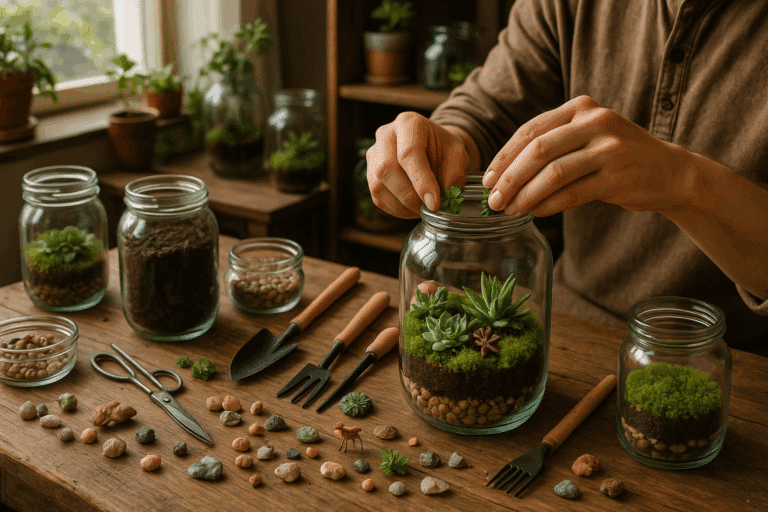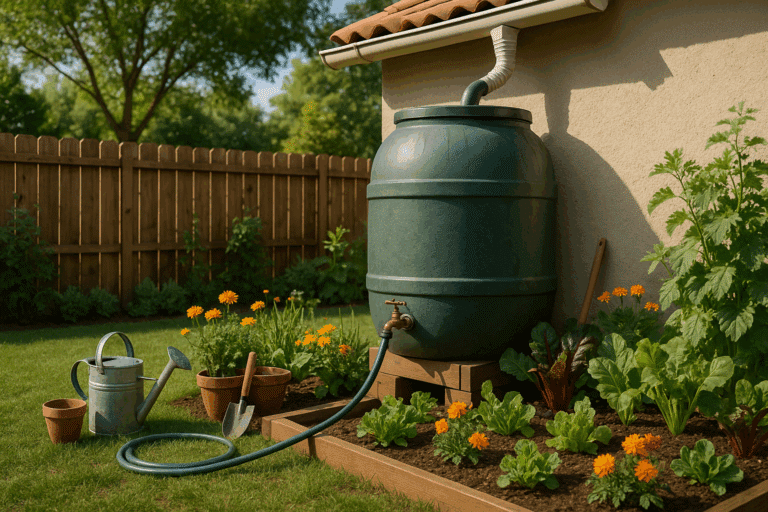😮 Sounds impossible? Think again! The idea might sound a little ‘out there’, but trust me, it’s not only possible but also incredibly simple. All you need is a little bit of elbow grease, some everyday materials, and a dose of patience. The result? An incredibly satisfying, environmentally-friendly project, that will not only reduce your waste but also reward you with nutrient-rich compost for your plants. We are talking about creating your own DIY pallet compost bin. 🌿
In this modern, fast-paced world, we are all aware of the pressing issue of waste generation. Did you know that each person produces an average of 4.5 pounds of waste per day? That’s a staggering amount. But there’s a bright side to this. You can utilize this waste, particularly organic waste, and convert it into something valuable – compost. Now, isn’t that an ingenious way of going ‘green’? This is what we will be discussing in this article – the art of mastering the DIY pallet compost bin for a greener lifestyle. 🌍
Composting has numerous benefits. It reduces landfill waste, cuts down on the production of harmful greenhouse gases, and encourages the growth of healthy plants. But the biggest advantage? It’s a fantastic DIY project that you can undertake right in your backyard or balcony. No need for expensive tools or materials. All you need are a few wooden pallets, nails, and some protective mesh. But wait, there’s more to it! The process of building and maintaining a pallet compost bin is a great learning experience, especially for kids. It teaches them valuable lessons about recycling, sustainability, and the importance of taking care of our planet. 🌱
What’s in Store for You? 📚
In the upcoming sections, we will delve into the nitty-gritty of building your own pallet compost bin. We will start with the basics – understanding what composting is, the science behind it, and why it’s beneficial for you and the environment. We will then move onto a step-by-step guide on how to build a compost bin from wooden pallets. But don’t worry if you’re not a seasoned DIYer. We will break it down in such a way that even beginners can follow along easily. 👍
Then comes the fun part – maintaining your compost bin. Composting is not a ‘set it and forget it’ kind of project. It requires regular maintenance to ensure the composting process is happening correctly. We will discuss what kind of waste you can compost, how to layer your compost bin, how often to turn your compost, and how to troubleshoot common composting problems.
Finally, we will explore how to use your fresh compost in your garden or pots. Compost is a gardener’s gold, and we will give you tips and tricks on how to make the most out of it. From enriching your soil to growing healthier plants, we will cover it all! 🌻
So, are you ready to embark on this exciting, environmentally-friendly DIY journey? Whether you’re a seasoned gardener looking to make your own compost or a newbie looking to dip your toes into the world of DIY and sustainability, this guide is for you. Let’s dive in and turn that waste into gold! 💪🌟
🍃Turning Trash into Treasure: Understanding the Value of Composting
When it comes to greener living, one of the most effective methods to adopt is composting. Not only does this technique promote healthier plant growth, but it also helps reduce landfill waste. However, many are deterred by the misconception that composting is a complicated process requiring sophisticated equipment. In reality, creating a Do-It-Yourself (DIY) compost bin from pallets is not only feasible but can also be a fun and rewarding endeavor.
Before we delve into how to build your own pallet compost bin, let’s first understand the science behind composting. Essentially, it’s a natural process in which organic waste materials decompose into a rich soil conditioner. The decomposed matter, or compost, is teeming with nutrients essential for plant growth. Composting not only reduces household waste but also enriches garden soil, reducing the need for chemical fertilizers.
A key element of successful composting is the compost bin, which provides an ideal environment for organic matter to decompose efficiently. There are many types of compost bins available in the market, but a DIY pallet compost bin offers a cost-effective and sustainable option.
🛠 Constructing Your DIY Pallet Compost Bin: Step-by-Step Guide
Building a compost bin from pallets can be a simple and straightforward process, with the right tools and guidance. The following steps will guide you through the construction of a three-bin system, which allows for continuous composting.
Before you begin, you will need the following materials:
- Four heat-treated wooden pallets (for a single bin)
- Twelve pallets for a three-bin system
- Galvanized nails or screws
- Wire mesh (optional)
- Hand saw, hammer, and wire cutters
Once you’ve gathered your materials, follow these steps:
1. Prepare the Pallets
First, check the condition of your pallets. Remove any protruding nails or splinters to ensure safety. If you choose to use wire mesh, attach it to the inside of each pallet. This helps to contain the compost materials and enhance aeration.
2. Construct the Bins
Now, it’s time to assemble your compost bins. Position your pallets in a square or rectangle formation, depending on the size of your pallets. Using the galvanized nails or screws, secure the corners of the pallets together. Repeat this process for all three bins.
3. Place the Bins
Choose a level, well-drained spot for your compost bins. They should be easily accessible, but not too close to living spaces, to avoid any potential odors disturbing your household.
🌿 Keys to Successful Composting: Balance, Aeration, and Moisture
Once your compost bins are ready, it’s time to start composting. Composting requires a balanced combination of ‘green’ and ‘brown’ materials. Green materials, such as fruit and vegetable scraps, provide nitrogen and are the primary source of compost bacteria. Brown materials, such as leaves, straw, or paper, supply carbon and act as a bulking agent that aids in aeration.
For successful composting, you should aim for a green-to-brown ratio of 1:2. This balance ensures efficient decomposition and prevents odorous gases from forming. Check out the table below for a list of common compostable materials:
| Green Materials | Brown Materials |
| Fruit and vegetable scraps | Leaves |
| Coffee grounds | Straw |
| Grass clippings | Newspaper |
In addition to a balanced compost mix, proper aeration is crucial. Regular turning of the compost pile with a pitchfork or shovel facilitates airflow, speeding up the decomposition process. Lastly, maintain a suitable moisture level. Your compost pile should be as wet as a wrung-out sponge.
📺 Composting Videos: Learn from the Experts
If you’re a visual learner, watching videos on composting can be incredibly helpful. Here are a couple of YouTube videos that provide excellent demonstrations on building a pallet compost bin and maintaining it:
1. “DIY Pallet Compost Bin – Cheap & Easy Build!” by The Carpenter’s Daughter
This video offers a clear, step-by-step guide on constructing a pallet compost bin. It also provides handy tips on sourcing pallets and ensuring they’re safe to use.
2. “How to Make Compost – The Ultimate Compost Bin” by OneYardRevolution: Frugal & Sustainable Organic Gardening
This comprehensive video explains the science of composting, as well as offering practical advice on maintaining the compost pile and troubleshooting common issues.
💚Embrace the Green Thumb: The Beauty of Composting
As we journey towards a more sustainable lifestyle, composting is an essential practice to adopt. By creating your own pallet compost bin, you’re not just reducing waste, but also contributing to a greener and healthier environment. The beauty of composting is that it turns what is often viewed as waste into a valuable resource. So why wait? Roll up your sleeves and let’s turn waste into gold!

Conclusion
In conclusion, after a comprehensive journey through the intricacies of the software engineering landscape, we’ve addressed a series of critical points that are instrumental in understanding the field. This venture allowed us to delve into the depths of methodologies, best practices, principles, and the importance of quality assurance, and how these aspects collectively shape the software engineering landscape.
We’ve discussed the methodologies that offer a structured approach to software development, including Agile, Scrum, and DevOps. We’ve touched upon the fact that these methodologies are not “one size fits all,” but rather need to be adapted to specific contexts. Whether it is the flexibility of Agile, the focus on continuous improvement in Scrum, or the culture of collaboration and communication in DevOps, we’ve acknowledged the unique benefits of each methodology.
Furthermore, we explored the essence of software engineering principles such as modularity, robustness, usability, and performance. These principles are the building blocks of a successful software engineering project, acting as a compass to guide engineers through the development process. By adhering to these principles, engineers can ensure they are building reliable, efficient, and user-friendly software.
The discussion also led us to the realm of quality assurance, underlining its significance in ensuring the software’s reliability, efficiency, and performance. We’ve emphasized that quality assurance is not a one-time effort, but a continuous process that goes hand in hand with the software development lifecycle.
As we look back at our journey, we recognize the vastness of the software engineering field and the importance of ongoing learning. We encourage you to keep exploring, keep questioning, and keep evolving. The world of software engineering is ever-changing, and staying up-to-date is key to staying relevant in the field.
To delve deeper into the topics discussed, here are some resources for further reading:
– [Agile Methodology](https://www.agilealliance.org/agile101/)
– [Scrum Guide](https://www.scrumguides.org/)
– [DevOps Handbook](https://www.amazon.com/DevOps-Handbook-World-Class-Reliability-Organizations/dp/1942788002)
We invite you to share your thoughts, experiences, and learnings in the comments section below. The best learning often comes from sharing and discussing with peers. If you’ve found this article useful, feel free to share it with your network. Together, we can all grow and succeed in the fascinating world of software engineering.
As we conclude, let’s remember that software engineering is not merely about building software; it’s about crafting solutions that make the world a better place. Every line of code is an opportunity to make a difference. So, let’s keep coding, keep innovating, and keep making a difference. After all, isn’t that what being a software engineer is all about? 🚀💻🌐
Reference:
– Software Engineering: A Practitioner’s Approach by Roger S. Pressman
– The Pragmatic Programmer by Andrew Hunt and David Thomas
– The Mythical Man-Month: Essays on Software Engineering by Frederick P. Brooks Jr.
– Agile Software Development, Principles, Patterns, and Practices by Robert C. Martin.
Note: Ensure that all the links and references are from active sources.



